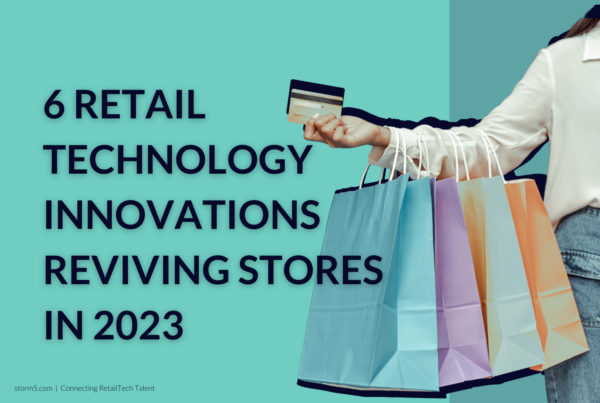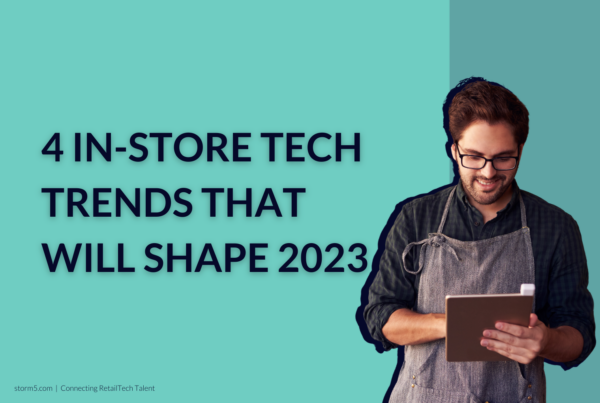4 RetailTech Trends To Watch In 2022
Both e-commerce and in-store RetailTech have been impacted by the accelerated digital revolution we’ve seen in the last year. Many companies face difficulty in staying…

Both e-commerce and in-store RetailTech have been impacted by the accelerated digital revolution we’ve seen in the last year. Many companies face difficulty in staying on top of RetailTech trends. Due to new consumer buying habits and expectations, as well as market economics, the retail technology environment continues to change. The key is to understand which RetailTech trends are here to stay and to ask yourself how you can incorporate them into your business.
E-commerce trends in RetailTech
Augmented Reality
Augmented Reality (AR) technology integrates digital data with the physical environment in real-time. It enables the virtual modification of a user’s environment or complete immersion in a simulated environment by sensory devices. According to Statista, the global AR and Virtual Reality (VR) market will grow significantly in the coming years, reaching $296.9 billion in 2024 as part of the larger extended reality (XR) industry.
Retailers have adopted what is known as ‘virtual try-on’ technology by utilizing Augmented Reality. Customers can try on products using camera-equipped devices, such as smartphones, to see how they look on them, as well as test the style, size, and fit before committing to a purchase. This trend is a game-changer for brands, especially in the aftermath of a pandemic, as customers now have a personalized and convenient means to access products in a realistic setting. Studies have shown that using this technology has reduced the rate of returns, with Shopify experiencing a 40% decrease in returns last year as a result of AR visualization. Large retailers such as IKEA and Macy’s have experimented with the technology, with positive results, demonstrating that it is a worthwhile technology to consider investing in.
Integrated loyalty program
For all business owners, customer loyalty is paramount for success. Nowadays, tech-enabled rewards and loyalty programs are being implemented to build and sustain relationships with customers.
Given our digital age, the vast majority of consumers own smartphones, allowing them to access mobile apps. Mobile apps are a key channel in boosting loyalty and engagement in the loyalty landscape, especially post-pandemic, as more consumers have turned to online shopping, implying that digital loyalty is required to increase sales by maintaining a loyal customer base.
So, what else is driving this trend? To put it simply, app experiences are better since they are more personalized and there is the ability to send customized rewards directly to users. Once gathered, this information can show patterns between performance and results. Take, for example, Starbucks, which has one of the most successful app-based loyalty programs. Users can order ahead of time, customize orders in real-time, and pay with cash, credit/debit card, or select mobile apps. Starbucks has revealed that this program has 22.9 million 90-day active members, up 18% from a year ago. This demonstrates how incorporating digital reward programs can enhance engagement and ultimately revenue.
In-Store Retail Technologies
Artificial Intelligence
Artificial intelligence (AI) refers to a computer’s or machine’s ability to mimic the capabilities of the human mind, which often learns from previous experiences to understand and respond to language, decisions, and issues. Teradata found that 80% of enterprises report that their organization already has some form of AI in production. One of the largest reasons for AI is based on improving customer experience.
AI has been utilized for a variety of purposes, including size sorting on clothing retailer websites, determining consumer preferences, improving store navigation, and inventory management, to name a few. Cashier-less technology is one of the most recent AI innovations. More and more businesses are becoming interested in this technology, which was sparked by Amazon Go’s check-out-free stores. Amazon announced “Just Walk Out” in 2020, a division dedicated to selling cashier-less technology to other retailers. The appeal of such technology is enhanced convenience and speed for consumers, while businesses benefit from collecting consumer data to analyze their buying habits and cutting labor expenses.
Touch-free Retail
The multi-sensory experience is a significant advantage of in-store purchasing over online shopping. What do shops do when touch is no longer an option for the general public? Customers want to buy safely while still enjoying the actual store experience, therefore touch-free technology has become more popular in the last 12 months. 87 percent of US buyers prefer to purchase in stores that offer touchless or other advanced self-checkout options.
One of the major advantages of contactless technology is improved hygiene and accessibility for a broader range of consumers who were previously overlooked which is a huge benefit for retailers because it increases inclusivity.
There are many more retail technology trends to come as the market advances and innovates on a daily basis. Take a look at the distinction between RetailTech and E-commerce for more information on Retail Technology. As RetailTech and E-commerce recruiters, we can help you find technically skilled candidates that will bring incredible experience to your organization. Please get in touch if you would like to discuss your recruitment requirements!







